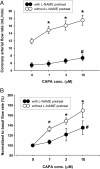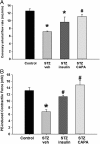Caffeic acid phenethyl amide improves glucose homeostasis and attenuates the progression of vascular dysfunction in Streptozotocin-induced diabetic rats
- PMID: 23829275
- PMCID: PMC3706244
- DOI: 10.1186/1475-2840-12-99
Caffeic acid phenethyl amide improves glucose homeostasis and attenuates the progression of vascular dysfunction in Streptozotocin-induced diabetic rats
Abstract
Background: Glucose intolerance and cardiovascular complications are major symptoms in patients with diabetes. Many therapies have proven beneficial in treating diabetes in animals by protecting the cardiovascular system and increasing glucose utilization. In this study, we evaluated the effects of caffeic acid phenethyl amide (CAPA) on glucose homeostasis and vascular function in streptozotocin (STZ)-induced type 1 diabetic rats.
Methods: Diabetes (blood glucose levels > 350 mg/dL), was induced in Wistar rats by a single intravenous injection of 60 mg/kg STZ. Hypoglycemic effects were then assessed in normal and type 1 diabetic rats. In addition, coronary blood flow in Langendorff-perfused hearts was evaluated in the presence or absence of nitric oxide synthase (NOS) inhibitor. The thoracic aorta was used to measure vascular response to phenylephrine. Finally, the effect of chronic treatment of CAPA and insulin on coronary artery flow and vascular response to phenylephrine were analyzed in diabetic rats.
Results: Oral administration of 0.1 mg/kg CAPA decreased plasma glucose in normal (32.9 ± 2.3% decrease, P < 0.05) and diabetic rats (11.8 ± 5.5% decrease, P < 0.05). In normal and diabetic rat hearts, 1-10 μM CAPA increased coronary flow rate, and this increase was abolished by 10 μM NOS inhibitor. In the thoracic aorta, the concentration/response curve of phenylephrine was right-shifted by administration of 100 μM CAPA. Coronary flow rate was reduced to 7.2 ± 0.2 mL/min at 8 weeks after STZ-induction. However, 4 weeks of treatment with CAPA (3 mg/kg, intraperitoneal, twice daily) started at 4 weeks after STZ induction increased flow rate to 11.2 ± 0.5 mL/min (P < 0.05). In addition, the contractile response induced by 1 μM phenylephrine increased from 6.8 ± 0.6 mN to 11.4 ± 0.4 mN (P < 0.05) and 14.9 ± 1.4 mN (P < 0.05) by insulin (1 IU/kg, intraperitoneal) or CAPA treatment, respectively.
Conclusions: CAPA induced hypoglycemic activity, increased coronary blood flow and vascular response to phenylephrine in type 1 diabetic rats. The increase in coronary blood flow may result from endothelial NOS activation. However, the detailed cellular mechanisms need to be further evaluated.
Figures






Similar articles
-
Caffeic acid phenethyl amide ameliorates ischemia/reperfusion injury and cardiac dysfunction in streptozotocin-induced diabetic rats.Cardiovasc Diabetol. 2014 Jun 12;13:98. doi: 10.1186/1475-2840-13-98. Cardiovasc Diabetol. 2014. PMID: 24923878 Free PMC article.
-
Caffeic acid phenethyl ester, a 5-lipoxygenase enzyme inhibitor, alleviates diabetic atherosclerotic manifestations: effect on vascular reactivity and stiffness.Chem Biol Interact. 2014 Apr 25;213:28-36. doi: 10.1016/j.cbi.2014.01.019. Epub 2014 Feb 6. Chem Biol Interact. 2014. PMID: 24508943
-
Caffeic acid phenethyl ester (CAPE) exhibits significant potential as an antidiabetic and liver-protective agent in streptozotocin-induced diabetic rats.Pharmacol Res. 2009 Oct;60(4):270-6. doi: 10.1016/j.phrs.2009.03.017. Epub 2009 Apr 7. Pharmacol Res. 2009. PMID: 19717012
-
Protective Effects of Caffeic Acid Phenethyl Ester (CAPE) and Novel Cape Analogue as Inducers of Heme Oxygenase-1 in Streptozotocin-Induced Type 1 Diabetic Rats.Int J Mol Sci. 2019 May 17;20(10):2441. doi: 10.3390/ijms20102441. Int J Mol Sci. 2019. PMID: 31108850 Free PMC article.
-
Cardiovascular Effects of Caffeic Acid and Its Derivatives: A Comprehensive Review.Front Physiol. 2020 Nov 27;11:595516. doi: 10.3389/fphys.2020.595516. eCollection 2020. Front Physiol. 2020. PMID: 33343392 Free PMC article. Review.
Cited by
-
Protective Effects and Mechanisms of N-Phenethyl Caffeamide from UVA-Induced Skin Damage in Human Epidermal Keratinocytes through Nrf2/HO-1 Regulation.Int J Mol Sci. 2019 Jan 4;20(1):164. doi: 10.3390/ijms20010164. Int J Mol Sci. 2019. PMID: 30621167 Free PMC article.
-
Novel CoQ10 antidiabetic mechanisms underlie its positive effect: modulation of insulin and adiponectine receptors, Tyrosine kinase, PI3K, glucose transporters, sRAGE and visfatin in insulin resistant/diabetic rats.PLoS One. 2014 Feb 20;9(2):e89169. doi: 10.1371/journal.pone.0089169. eCollection 2014. PLoS One. 2014. PMID: 24586567 Free PMC article.
-
Caffeic acid phenethyl amide ameliorates ischemia/reperfusion injury and cardiac dysfunction in streptozotocin-induced diabetic rats.Cardiovasc Diabetol. 2014 Jun 12;13:98. doi: 10.1186/1475-2840-13-98. Cardiovasc Diabetol. 2014. PMID: 24923878 Free PMC article.
-
Tropisetron modulates peripheral and central serotonin/insulin levels via insulin and nuclear factor kappa B/receptor for advanced glycation end products signalling to regulate type-2 diabetes in rats.RSC Adv. 2018 Mar 27;8(22):11908-11920. doi: 10.1039/c7ra13105d. eCollection 2018 Mar 26. RSC Adv. 2018. PMID: 35539384 Free PMC article.
-
N-Octyl Caffeamide, a Caffeic Acid Amide Derivative, Prevents Progression of Diabetes and Hepatic Steatosis in High-Fat Diet Induced Obese Mice.Int J Mol Sci. 2022 Aug 11;23(16):8948. doi: 10.3390/ijms23168948. Int J Mol Sci. 2022. PMID: 36012215 Free PMC article.
References
-
- Fowler MJ. Microvascular and macrovascular complications of diabetes. Clinical Diabetes. 2008;26:77–82. doi: 10.2337/diaclin.26.2.77. - DOI
Publication types
MeSH terms
Substances
LinkOut - more resources
Full Text Sources
Other Literature Sources
Medical

